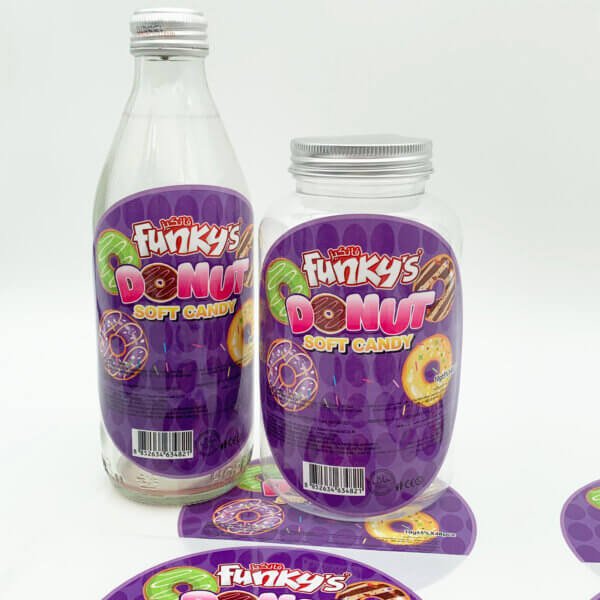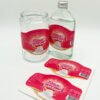In the modern food industry, roll stickers labels have become an essential component of packaging and product labeling. Particularly in the food sector, roll labels are not just part of the packaging but also serve multiple functions, including information delivery, brand promotion, and regulatory compliance.
1. What Are Food Roll Labels?
Food roll labels refer to labels specifically designed for food packaging, typically in a roll format, which can be applied automatically or manually to product containers. Due to their convenience, cost-effectiveness, and efficiency, roll labels are widely used in the food and beverage industry and have become one of the most common packaging solutions in the market.
2. Uses of Food Roll Stickers
- Product Information Display
Food roll labels are often used to display essential product information such as the product name, ingredients, nutritional facts, production date, expiration date, and the manufacturer’s details. This not only helps consumers understand basic product information but also ensures compliance with regulations. - Brand Promotion
Roll labels are also an important tool for brand promotion. By designing unique brand logos, color schemes, and patterns on the labels, companies can enhance the visual appeal of their products and increase consumer brand recognition. Eye-catching designs can effectively boost sales, especially on retail shelves. - Regulatory Compliance
In many countries, food labels must meet strict legal requirements, ensuring that consumers receive accurate nutritional information, ingredient lists, and other details. Food roll labels can be customized to meet these regulatory requirements, ensuring the product is compliant with food safety and labeling laws. - Logistics Management
In some cases, food roll labels are also used in logistics management, providing batch numbers, production dates, and storage conditions. This information helps to effectively track product movement and ensure product quality and food safety.
3. Design Considerations for Food Roll Stickers
The design of food roll labels must not only take visual appeal into account but also prioritize functionality and completeness of information. Below are some key considerations when designing food roll labels:
- Clarity and Readability
The text on the label should be clear, concise, and easy to read. Choosing appropriate fonts, sizes, and colors ensures that consumers can quickly access key information. Avoid overloading the design with too many elements that might hinder readability. - Brand Consistency
Label designs should align with the overall brand image, including color schemes, patterns, and font styles. Consistency with the brand’s identity helps build consumer trust and increases brand loyalty. - Regulatory Compliance
The design must adhere to local food labeling regulations, ensuring that all required information, such as nutritional facts, allergens, and storage instructions, is included and accurate. - Adaptability to Different Packaging Types
Food roll labels need to be designed to fit various types of packaging to ensure they can be smoothly applied to different surfaces, such as glass bottles, plastic bags, or metal cans.
4. How to Choose the Right Food Roll Labels
When selecting food roll labels, it’s important to consider several factors beyond just the design:
- Material Selection
The material of the label significantly impacts its durability and suitability for the intended environment. Common materials for food labels include paper, plastic, and synthetic materials. The choice of material should be based on the storage conditions of the product (e.g., moist or low-temperature environments). - Print Quality
High-quality printing ensures that the information on the label is clear and visible, enhancing its overall visual appeal. Choosing a supplier with excellent print quality is key to achieving a professional result. - Environmental Friendliness
With growing awareness of environmental issues, many consumers and companies are now more concerned with the sustainability of their packaging. Opting for eco-friendly materials or recyclable labels can reduce environmental impact and improve the brand’s social responsibility image. - Cost-Effectiveness
As food labels are typically produced in large quantities, cost control is an important factor when selecting a supplier. Reasonable pricing, reliable supply capacity, and efficient production processes are key considerations when choosing a label supplier.
5. Conclusion Custom roll stickers
Food roll labels, as an integral part of modern food packaging, play a crucial role not only in product labeling, brand promotion, and regulatory compliance but also in providing consumers with convenient access to important information. By focusing on thoughtful design, material selection, and supplier choice, food roll labels can effectively enhance product sales, strengthen brand value, and ensure food safety.
Looking ahead, with the increasing emphasis on environmental sustainability, food roll labels may increasingly focus on eco-friendly materials and smart labeling technologies, bringing new opportunities and challenges to the food packaging industry.

custom roll of stickers stickers roll roll of stickers











